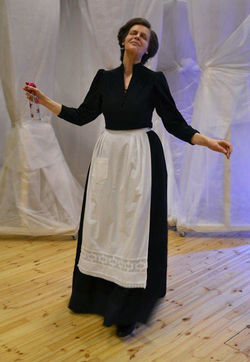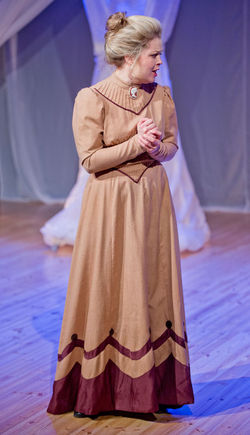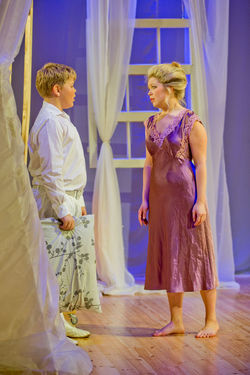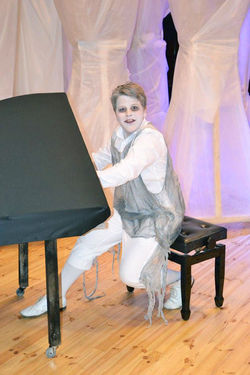
KRUVIPÖÖRE
Autor: Benjamin Britten
Dirigent: Ingrid Roose; Lavastaja: Laura Kalle
Kunstnik: Mirjam Aimla; Valguskunstnik: Mari-Riin Villemsoo
Dekoratsioonid: Eerik Kask
Kammerooper
Rahvusooper Estonia kammersaal
2016
"Kruvipööre" on Benjamin Britteni kammerooper, mis on kirjutatud kolmele sopranile, tüdruksopranile, poiss-sopranile ja tenorile. Ooperi libreto aluseks on Henry Jamesi samanimeline kummitusjutt. "Kruvipöörde" tegelasteks on lapsed ja vaimud ning loo tegevustik keerdub lahti vanas majas, mis ei taha oma minevikust lahti lasta. Benjamin Britteni kammerooper "Kruvipööre" jõudis lavale mitme Eesti kõrgkooli üliõpilaste abiga. Nii lavastaja, dirigent, produtsent kui ka lauljad ja orkestrandid õpivad Eesti Muusika- ja Teatriakadeemias, kunstnikud on Eesti Kunstiakadeemiast ja Tallinna Tehnikakõrgkoolist ning valguskunstnik Tartu Ülikooli Viljandi Kultuuriakadeemiast.
Kostüümikujunduses otsustasin kasutada põhiliselt must-valget koloriiti, rõhutades kontrasti elamisse saabunud guvernandi ning majaelanike vahel. Guvernandi välimuse lahendasin ainsa tegelasena soojades toonides, kasutades pastelseid beeže, roosakaid ja ploomikarva toone. Kummituste kostüümid tegin üleni mustad, igas mõttes, kuna tegemist oli justkui surnust üles tõusnud tegelastega. Miss Jessel kandis enda kleidi osana kaasas järve, mille ääres teda sageli nähti ning Quint oli oma sambla, pori, risu ja ämblikuvõrkudega kaetud pintsakuga otse kraavipervelt maa seest välja roninud. Veidi värvilaike lisasid neile vaid järvevee sillerdus ja detailid pintsakult. Lapsed olid esimeses vaatuses kui pabernukud, üleni lumivalgesse riietatud, puhtad, viisakad ja roosapõsksed. Teises vaatuses, kui vaimud olid nad enda võimusesse haaranud, lisandusid ka laste kostüümidele ämblikuvõrku imiteerivad elemendid ning ka grimm muutus hirmuäratavamaks. Mrs Grose laste hooldajana seisis nende kahe maailma keskel ning oli ka oma ametile sobivalt riietatud must-valgesse. Leidsin, et taoline koloriidimäng sobib hästi kammersaali poolt pakutava sooja puidu ning lavastuse kujunduses kasutatava valge õhulise kangaga. Rõivastiilid vihjasid mõneti 19. sajandi keskpaigale, kuid jäid lavastaja soovil täpselt ajastusse määratlematuks. Laste kostüümid püüdsin teha sellised, et samad rõivad oleksid lihtsalt muudetavad nii korralikeks igapäevariieteks kui ka ööriieteks ning usun, et see õnnestus.

THE TURN OF THE SCREW
Author: Benjamin Britten
Conductor: Ingrid Roose; Stage Director: Laura Kalle
Designer: Mirjam Aimla; Lighting Designer: Mari-Riin Villemsoo
Decorations: Eerik Kask
Chamber opera
Estonian National Opera Chamber Hall
2016
"Turn of the Screw" is Benjamin Britten’s chamber opera written for three sopranos, a girl soprano, boy-soprano and a tenor. The libretto of the opera is based on the ghost story of the same name by Henry James. The characters of the "Turn of the Screw" are children and ghosts and the activities of the story are unrolled in an old house, which doesn’t want to let go of its past. Benjamin Britten’s chamber opera "Turn of the Screw" was brought on stage with the help of various Estonian university students. The director, conductor, producer as well as the singers and orchestra players study in Estonian Academy of Music and Theatre, the artists are from Estonian Academy of Arts and Tallinn University of Applied Sciences and the lighting artist from Tartu University Viljandi Culture Academy.
In costume design, I decided to use mostly black and white colours, stressing the contrast between the governess who arrives at the house and the inhabitants of the house. The governess is the only character in the play whose appearance I decided to solve in warm tones, using pastel beige, pinkish and plum colours. The costumes of the ghosts were black in every sense, because those characters as if arose from the dead. As a part of her dress, Miss Jessel carried along a lake at which she was often seen and Quint with his jacket covered in moss, dirt, trash and spider nets was as if he just climbed out from the soil next to the moat. Some colour spots were added to them only by the flicker of the lake water and some details from the jacket. In the first act, the children looked like paper dolls, all clothed in snow-white, clean, diligent and pink-cheeked. In the second act, where the ghosts had clawed them into their power, the elements imitating spider webs were added to the children’s clothes and their make-up also got scarier. Mrs Grose as the children’s caretaker stood between these two worlds and was clad in black and white suitably to her profession. I thought that this colour game suited well with the warm wood of the chamber hall and the white airy fabric used in the design of the play. The clothing styles somewhat hinted at the mid-19th century, but at the wish of the director, their era could not be directly defined. I tried to create the clothing of the children in a way that they could be easily turned into neat daily clothes as well as night clothes and I believe I was successful.
 |  |  |
|---|---|---|
 |  |  |
 |  |  |
 |  |  |
 |  |  |
 |  |  |
 |  |